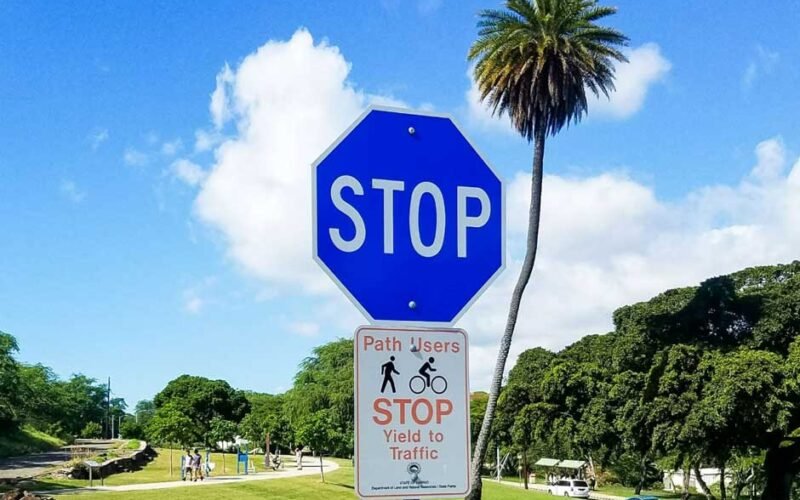In the world of road signs, colors and shapes play a vital role in ensuring safety, providing guidance, and delivering information to drivers and pedestrians. Among the array of traffic sign colors, blue holds a specific and critical meaning. If you’ve ever wondered what blue signs mean in the United States, this comprehensive guide will break it down for you.
The Purpose of Blue Signs in the United States
Blue signs are informational signs. They are designed to communicate services, directions, or guidance that isn’t necessarily regulatory or cautionary but still essential for travelers. Unlike red signs, which typically denote prohibitions, or yellow signs that signal warnings, blue signs offer practical, non-urgent information.
In the United States, blue signs are primarily associated with:
- Services for travelers
- General guidance
- Evacuation routes
- Handicap accessibility
Let’s explore these categories in more detail.
-
Traveler Services and Amenities
Blue signs are commonly used to direct drivers to essential services. These signs are typically found along highways, interstates, and major roads, providing information about:
- Rest areas: Locations where travelers can stop to use restrooms, stretch their legs, or take a break from driving.
- Gas stations: Fuel availability along the route.
- Restaurants: Dining options within the vicinity.
- Lodging: Hotels or motels nearby for overnight stays.
- Hospitals: Emergency medical facilities or urgent care centers.
For instance, if you’re driving on an interstate and spot a blue sign with icons for food, lodging, and fuel, it’s a signal that these services are available at an upcoming exit.
-
General Information and Guidance
Blue signs also provide general guidance for non-emergency situations. Examples include:
- Parking signs: Blue parking signs often denote specific parking areas, such as visitor parking, short-term parking, or public parking lots.
- Scenic routes: In some regions, blue signs guide travelers to scenic or historic destinations, helping tourists make the most of their journey.
- Wayfinding: Blue signs help drivers navigate to points of interest, such as airports, state parks, or recreational areas.
These signs ensure that drivers have the information they need without adding unnecessary stress to their journey.
-
Evacuation Routes
In coastal states or areas prone to natural disasters, blue signs mark evacuation routes. These routes are pre-planned paths that guide residents and visitors to safety during emergencies such as hurricanes, wildfires, or floods.
Evacuation route signs are typically accompanied by arrows indicating the direction drivers should follow. They are strategically placed to ensure a clear and efficient path away from danger zones.
-
Handicap Accessibility
One of the most universally recognized uses of blue signs is in marking accessible facilities. Blue is the standard color for signs indicating accessibility features for individuals with disabilities. Examples include:
- Handicap parking spaces
- Wheelchair-accessible entrances
- Accessible restrooms
- Pathways or ramps designed for mobility devices
These signs are not just informational; they also comply with the Americans with Disabilities Act (ADA), ensuring equal access for everyone.
The Design and Symbols on Blue Signs
Blue signs often feature white text, symbols, or pictograms for clarity and easy recognition. Some common symbols include:
- Fork and knife: Indicating a nearby restaurant.
- Gas pump: Signaling an upcoming fuel station.
- Bed: Representing available lodging.
- Letter “H”: Denoting a hospital or medical facility.
- Wheelchair icon: Indicating accessibility.
These universally understood symbols make it easier for drivers of all languages and literacy levels to interpret the information quickly.
Examples of Blue Signs on U.S. Roads
Here are some real-world examples of blue signs you’re likely to encounter while traveling in the United States:
-
Interstate Exit Service Signs
- Found near highway exits, these signs list available services, such as gas stations, fast food restaurants, and hotels. They often display corporate logos for easy brand recognition.
-
Rest Area Signs
- Located along interstates, these signs inform drivers about upcoming rest areas, often with details like whether the area has restrooms, picnic tables, or vending machines.
-
Hospital Directional Signs
- Found in urban areas or near highway exits, these signs direct drivers to the nearest hospital or emergency care facility. The prominent “H” symbol ensures quick identification.
-
Parking Lot Signs
- Blue signs in parking lots specify reserved spaces, such as those for visitors, employees, or individuals with disabilities.
-
Evacuation Route Signs
- Predominantly seen in hurricane-prone areas like Florida, Louisiana, and Texas, these signs guide residents to safety during emergencies.
Why Are Blue Signs Important?
The color blue was chosen for these signs because of its association with calmness, trust, and reliability. This aligns with their purpose: to provide information that helps travelers make informed decisions without causing alarm.
Some key reasons blue signs are essential include:
- Clarity: Their consistent use of color and design ensures drivers can quickly identify the type of information being provided.
- Safety: By offering guidance on services and evacuation routes, blue signs enhance overall road safety.
- Convenience: They provide critical information that improves the travel experience, from locating gas stations to finding accessible facilities.
How Do Blue Signs Differ from Other Colors?
Each color used in road signs in the United States has a specific meaning. Here’s how blue signs differ from other common colors:
- Red: Indicates prohibitive or regulatory actions (e.g., stop signs, no entry).
- Yellow: Warns drivers of potential hazards or changes in road conditions.
- Green: Provides directional information, such as distance to cities or exit signs.
- White: Displays regulatory information, such as speed limits.
- Orange: Alerts drivers to construction zones or temporary traffic changes.
- Brown: Highlights recreational or cultural points of interest.
Compared to these, blue signs are uniquely focused on information and services.
Blue Signs and Driver Expectations
Understanding what blue signs mean ensures that drivers can respond appropriately when encountering them. For example:
- A blue sign signaling a rest area might encourage a long-haul driver to plan a break.
- An evacuation route sign can provide peace of mind during severe weather conditions.
- Blue accessibility signs ensure facilities are inclusive and welcoming to everyone.
Drivers who know what blue signs mean are better equipped to navigate their journey safely and efficiently.
Frequently Asked Questions About Blue Signs
-
Are blue signs regulatory?
No, blue signs are informational. They do not enforce laws or regulations but instead provide guidance or directions.
-
Are all accessibility signs blue?
Yes, blue is the standard color for accessibility signs under ADA guidelines.
-
Why do evacuation routes use blue signs?
Blue signs are used for evacuation routes to stand out from the red and yellow signs commonly associated with prohibitions and warnings. The calming color helps reduce panic during emergencies.
-
Do blue signs appear on local roads or just highways?
Blue signs can appear on both local roads and highways, depending on the information being conveyed.
Conclusion
Blue signs play an indispensable role in the United States’ traffic sign system. They provide vital information about services, facilities, and directions without adding urgency or stress to the driving experience. Whether you’re searching for a rest area, navigating an evacuation route, or looking for accessible parking, blue signs are there to guide the way.
Understanding what blue signs mean enhances road safety, ensures inclusivity, and contributes to a more seamless travel experience for all. Next time you hit the road, keep an eye out for these helpful beacons of information!
If you want to learn more about traffic signs and road safety in the United States, explore additional resources and guides to improve your knowledge and driving confidence.










